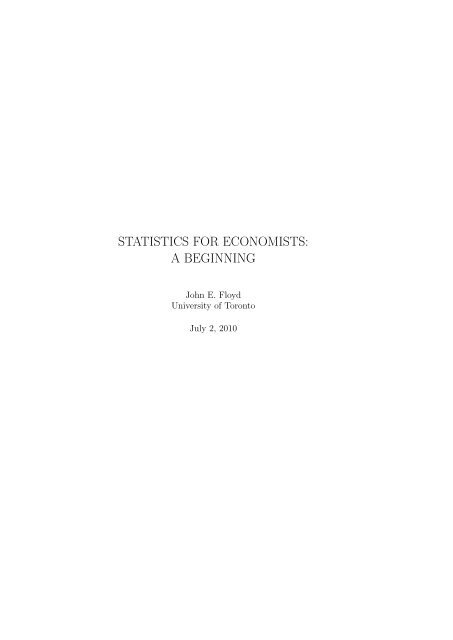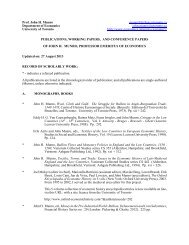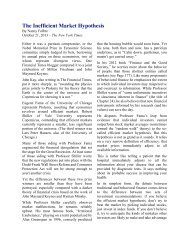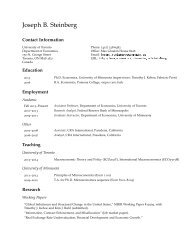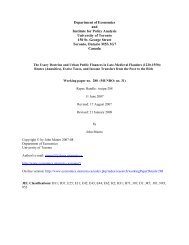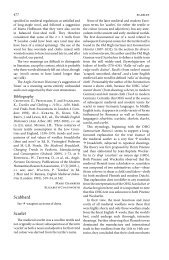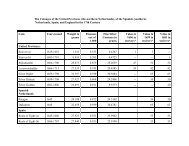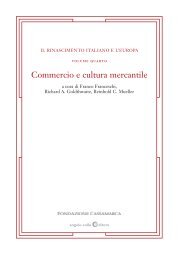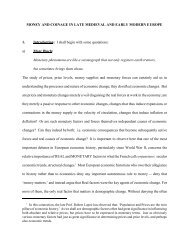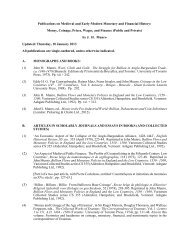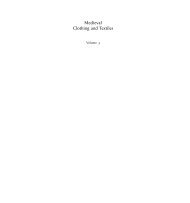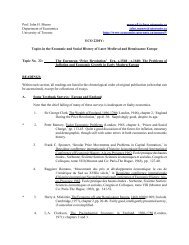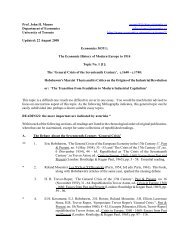STATISTICS FOR ECONOMISTS: A BEGINNING - Department of ...
STATISTICS FOR ECONOMISTS: A BEGINNING - Department of ...
STATISTICS FOR ECONOMISTS: A BEGINNING - Department of ...
You also want an ePaper? Increase the reach of your titles
YUMPU automatically turns print PDFs into web optimized ePapers that Google loves.
<strong>STATISTICS</strong> <strong>FOR</strong> <strong>ECONOMISTS</strong>:<br />
A <strong>BEGINNING</strong><br />
John E. Floyd<br />
University <strong>of</strong> Toronto<br />
July 2, 2010
PREFACE<br />
The pages that follow contain the material presented in my introductory<br />
quantitative methods in economics class at the University <strong>of</strong> Toronto. They<br />
are designed to be used along with any reasonable statistics textbook. The<br />
most recent textbook for the course was James T. McClave, P. George Benson<br />
and Terry Sincich, Statistics for Business and Economics, Eighth Edition,<br />
Prentice Hall, 2001. The material draws upon earlier editions <strong>of</strong> that<br />
book as well as upon John Neter, William Wasserman and G. A. Whitmore,<br />
Applied Statistics, Fourth Edition, Allyn and Bacon, 1993, which was used<br />
previously and is now out <strong>of</strong> print. It is also consistent with Gerald Keller<br />
and Brian Warrack, Statistics for Management and Economics, Fifth Edition,<br />
Duxbury, 2000, which is the textbook used recently on the St. George<br />
Campus <strong>of</strong> the University <strong>of</strong> Toronto. The problems at the ends <strong>of</strong> the chapters<br />
are questions from mid-term and final exams at both the St. George<br />
and Mississauga campuses <strong>of</strong> the University <strong>of</strong> Toronto. They were set by<br />
Gordon Anderson, Lee Bailey, Greg Jump, Victor Yu and others including<br />
myself.<br />
This manuscript should be useful for economics and business students enrolled<br />
in basic courses in statistics and, as well, for people who have studied<br />
statistics some time ago and need a review <strong>of</strong> what they are supposed to have<br />
learned. Indeed, one could learn statistics from scratch using this material<br />
alone, although those trying to do so may find the presentation somewhat<br />
compact, requiring slow and careful reading and thought as one goes along.<br />
I would like to thank the above mentioned colleagues and, in addition, Adonis<br />
Yatchew, for helpful discussions over the years, and John Maheu for<br />
helping me clarify a number <strong>of</strong> points. I would especially like to thank Gordon<br />
Anderson, who I have bothered so frequently with questions that he<br />
deserves the status <strong>of</strong> mentor.<br />
After the original version <strong>of</strong> this manuscript was completed, I received some<br />
detailed comments on Chapter 8 from Peter Westfall <strong>of</strong> Texas Tech University,<br />
enabling me to correct a number <strong>of</strong> errors. Such comments are much<br />
appreciated.<br />
c⃝J. E. Floyd, University <strong>of</strong> Toronto<br />
i<br />
J. E. Floyd<br />
July 2, 2010
Chapter 2<br />
Probability<br />
2.1 Why Probability?<br />
We have seen that statistical inference is a methodology through which we<br />
learn about the characteristics <strong>of</strong> a population by analyzing samples <strong>of</strong> elements<br />
drawn from that population. Suppose that a friend asks you to<br />
invest $10000 in a joint business venture. Although your friend’s presentation<br />
<strong>of</strong> the potential for pr<strong>of</strong>it is convincing, you investigate and find that<br />
he has initiated three previous business ventures, all <strong>of</strong> which failed. Would<br />
you think that the current proposed venture would have more than a 50/50<br />
chance <strong>of</strong> succeeding? In pondering this question you must wonder about<br />
the likelihood <strong>of</strong> observing three failures in a sample <strong>of</strong> three elements from<br />
the process by which your friend chooses and executes business ventures if,<br />
in fact, more than half the population <strong>of</strong> ventures emanating from that process<br />
will be successful. This line <strong>of</strong> thinking is an essential part <strong>of</strong> statistical<br />
inference because we are constantly asking ourselves, in one way or other,<br />
what the likelihood is <strong>of</strong> observing a particular sample if the population<br />
characteristics are what they are purported to be. Much <strong>of</strong> statistical inference<br />
involves making an hypothesis about the characteristics <strong>of</strong> a population<br />
(which we will later call the null hypothesis) and then seeing whether the<br />
sample has a low or high chance <strong>of</strong> occurring if that hypothesis is true.<br />
Let us begin our study <strong>of</strong> probability by starting with a population whose<br />
characteristics are known to us and inquire about the likelihood or chances<br />
<strong>of</strong> observing various samples from that population.<br />
35
36 PROBABILITY<br />
2.2 Sample Spaces and Events<br />
Suppose we toss a single coin and observe whether it comes up heads or<br />
tails. The relevant population here is the infinite sequence <strong>of</strong> tosses <strong>of</strong> a<br />
single coin. With each toss there is uncertainty about whether the result<br />
will be a head or a tail. This coin toss is an example <strong>of</strong> a random trial or<br />
experiment, which can be defined as an activity having two or more possible<br />
outcomes with uncertainty in advance as to which outcome will prevail. The<br />
different possible outcomes <strong>of</strong> the random trial are called the basic outcomes.<br />
The set <strong>of</strong> all basic outcomes for a random trial is called the sample space<br />
for the trial. The sample space for a single coin toss, which we denote by<br />
S, contains two basic outcomes, denoted as H (head) and T (tail). This<br />
represents a sample <strong>of</strong> one from the infinite population <strong>of</strong> single coin tosses.<br />
The set <strong>of</strong> basic outcomes can be written<br />
S = {H, T } (2.1)<br />
These basic outcomes are also called sample points or simple events. They<br />
are mutually exclusive—that is, only one can occur—and mutually exhaustive—that<br />
is, at least one <strong>of</strong> them must occur.<br />
Now suppose we toss two coins simultaneously and record whether they<br />
come up heads or tails. One might think that there would be three basic<br />
outcomes in this case—two heads, head and tail, and two tails. Actually,<br />
there are four simple events or sample points because the combination head<br />
and tail can occur in two ways—head first and then tail, and tail first followed<br />
by head. Thus, the sample space for this random trial or experiment<br />
will be<br />
S = {HH, HT, T H, T T } (2.2)<br />
A subset <strong>of</strong> the set <strong>of</strong> sample points is called an event. For example,<br />
consider the event ‘at least one head’. This would consist <strong>of</strong> the subspace<br />
E1 = {HH, HT, T H} (2.3)<br />
containing three <strong>of</strong> the four sample points. Another event would be ‘both<br />
faces same’. This event, which we can call E2, is the subset<br />
E2 = {HH, T T }. (2.4)<br />
The set <strong>of</strong> outcomes not contained in an event Ej is called the com-<br />
. Thus, the<br />
plementary event to the event Ej which we will denote by Ec j<br />
complementary events to E1 and E2 are, respectively,<br />
E c 1 = {T T } (2.5)
2.2. SAMPLE SPACES AND EVENTS 37<br />
and<br />
E c 2 = {HT, T H}. (2.6)<br />
The set <strong>of</strong> sample points that belongs to both event Ei and event Ej is<br />
called the intersection <strong>of</strong> Ei and Ej. The intersection <strong>of</strong> E1 and E c 2 turns<br />
out to be the event E c 2 because both sample points in Ec 2 are also in E1. We<br />
can write this as<br />
The intersection <strong>of</strong> E c 1 and Ec 2<br />
E1 ∩ E c 2 = {HT, T H} = E c 2. (2.7)<br />
contains no elements, that is<br />
E c 1 ∩ E c 2 = ϕ (2.8)<br />
where ϕ means nil or nothing. An event containing no elements is called the<br />
null set or null event. When the intersection <strong>of</strong> two events is the null event,<br />
those two events are said to be mutually exclusive. It should be obvious that<br />
the intersection <strong>of</strong> an event and its complement is the null event.<br />
The set <strong>of</strong> sample points that belong to at least one <strong>of</strong> the events Ei and<br />
Ej is called the union <strong>of</strong> Ei and Ej. For example, the union <strong>of</strong> E c 1 and Ec 2<br />
is<br />
E3 = E c 1 ∪ E c 2 = {HT, T H, T T }, (2.9)<br />
the event ‘no more than one head’. Each sample point is itself an event—one<br />
<strong>of</strong> the elementary events—and the union <strong>of</strong> all these elementary events is<br />
the sample space itself. An event that contains the entire sample space is<br />
called the universal event.<br />
We can express the intersection and union <strong>of</strong> several events as, respectively,<br />
E1 ∩ E2 ∩ E3 ∩ E4 ∩ · · · · · ·<br />
and<br />
E1 ∪ E2 ∪ E3 ∪ E4 ∪ · · · · · · .<br />
The set <strong>of</strong> all possible events that can occur in any random trial or<br />
experiment, including both the universal event and the null event, is called<br />
the event space.<br />
The above examples <strong>of</strong> random trials and sample spaces resulting therefrom<br />
represent perhaps the simplest cases one could imagine. More complex<br />
situations arise in experiments such as the daily change in the Dow Jones Industrial<br />
Average, the number <strong>of</strong> students <strong>of</strong> the College involved in accidents<br />
in a given week, the year-over-year rate <strong>of</strong> inflation in the United Kingdom,<br />
and so forth. Sample points, the sample space, events and the event space<br />
in these more complicated random trials have the same meanings and are<br />
defined in the same way as in the simple examples above.
38 PROBABILITY<br />
2.3 Univariate, Bivariate and Multivariate Sample<br />
Spaces<br />
The sample space resulting from a single coin toss is a univariate sample<br />
space—there is only one dimension to the random trial. When we toss two<br />
coins simultaneously, the sample space has two dimensions—the result <strong>of</strong><br />
the first toss and the result <strong>of</strong> the second toss. It is <strong>of</strong>ten useful to portray<br />
bivariate sample spaces like this one in tabular form as follows:<br />
One<br />
Two H T<br />
H HH TH<br />
T HT TT<br />
Each <strong>of</strong> the four cells <strong>of</strong> the table gives an outcome <strong>of</strong> the first toss followed<br />
by an outcome <strong>of</strong> the second toss. This sample space can also be laid out in<br />
tree form:<br />
✑ ✑✑✑✑✑<br />
◗ ◗◗◗◗◗<br />
First<br />
Toss<br />
H<br />
T<br />
✏ ✏✏✏✏✏<br />
<br />
✏ ✏✏✏✏✏<br />
<br />
Second<br />
Toss<br />
H<br />
T<br />
H<br />
T<br />
✲<br />
✲<br />
✲<br />
✲<br />
Sample<br />
Points<br />
H H<br />
H T<br />
T H<br />
T T<br />
A more interesting example might be the parts delivery operation <strong>of</strong> a<br />
firm supplying parts for oil drilling rigs operating world wide. The relevant<br />
random trial is the delivery <strong>of</strong> a part. Two characteristics <strong>of</strong> the experiment<br />
are <strong>of</strong> interest—first, whether the correct part was delivered and second, the<br />
number <strong>of</strong> days it took to get the part to the drilling site. This is also a<br />
bivariate random trial the essence <strong>of</strong> which can be captured in the following<br />
table:
BIVARIATE SAMPLE SPACES 39<br />
Time <strong>of</strong> Delivery<br />
S N M<br />
Order C C S C N C M<br />
Status I I S I N I M<br />
The status <strong>of</strong> the order has two categories: ‘correct part’ (C) and ‘incorrect<br />
part’ (I). The time <strong>of</strong> delivery has three categories: ‘same day’ (S),<br />
‘next day’ (N) and ‘more than one day’ (M). There are six sample points or<br />
basic outcomes. The top row in the table gives the event ‘correct part’ and<br />
the bottom row gives the event ‘incorrect part’. Each <strong>of</strong> these events contain<br />
three sample points. The first column on the left in the main body <strong>of</strong> the<br />
table gives the event ‘same day delivery’, the middle column the event ‘next<br />
day delivery’ and the third column the event ‘more than one day delivery’.<br />
These three events each contain two sample points or basic outcomes. The<br />
event ‘correct part delivered in less than two days’ would be the left-most<br />
two sample points in the first row, (C S) and (C N). The complement <strong>of</strong> that<br />
event, ‘wrong part or more than one day delivery’ would be the remaining<br />
outcomes (C M), (I S), (I N) and (I M).<br />
Notice also that the basic outcome in each cell <strong>of</strong> the above table is the<br />
intersection <strong>of</strong> two events—(C S) is the intersection <strong>of</strong> the event C or ‘correct<br />
part’ and the event S ‘same day delivery’ and (I N) is the intersection <strong>of</strong><br />
the event I, ‘incorrect part’, and the event N ‘next day delivery’. The event<br />
‘correct part’ is the union <strong>of</strong> three simple events, (C S) ∪ (C N) ∪ (C M).<br />
The parts delivery sample space can also be expressed in tree form as follows:<br />
✑ ✑✑✑✑✑<br />
◗ ◗◗◗◗◗<br />
Order<br />
Status<br />
C<br />
I<br />
✏ ✏✏✏✏✏<br />
<br />
✏ ✏✏✏✏✏<br />
<br />
Delivery<br />
Time<br />
S<br />
N<br />
M<br />
S<br />
N<br />
M<br />
✲<br />
✲<br />
✲<br />
✲<br />
✲<br />
✲<br />
Sample<br />
Points<br />
C S<br />
C N<br />
C M<br />
I S<br />
I N<br />
I M
40 PROBABILITY<br />
2.4 The Meaning <strong>of</strong> Probability<br />
Although probability is a term that most <strong>of</strong> us used before we began to study<br />
statistics, a formal definition is essential. As we noted above, a random trial<br />
is an experiment whose outcome must be one <strong>of</strong> a set <strong>of</strong> sample points<br />
with uncertainty as to which one it will be. And events are collections<br />
<strong>of</strong> sample points, with an event occurring when one <strong>of</strong> the sample points<br />
or basic outcomes it contains occurs. Probability is a value attached to a<br />
sample point or event denoting the likelihood that it will be realized. These<br />
probability assignments to events in the sample space must follow certain<br />
rules.<br />
1. The probability <strong>of</strong> any basic outcome or event consisting <strong>of</strong> a set <strong>of</strong> basic<br />
outcomes must be between zero and one. That is, for any outcome oi or<br />
event Ei containing a set <strong>of</strong> outcomes we have<br />
0 ≤ P (oi) ≤ 1<br />
0 ≤ P (Ei) ≤ 1. (2.10)<br />
If P (oi) = 1 or P (Ei) = 1 the respective outcome or event is certain to<br />
occur; if P (oi) = 0 or P (Ei) = 0 the outcome or event is certain not to<br />
occur. It follows that probability cannot be negative.<br />
2. For any set <strong>of</strong> events <strong>of</strong> the sample space S (and <strong>of</strong> the event space E),<br />
P (Ej) =<br />
J∑<br />
P (oi). (2.11)<br />
i=1<br />
where J is the number <strong>of</strong> basic events or sample points contained in the<br />
event Ej. In other words, the probability that an event will occur is the<br />
sum <strong>of</strong> the probabilities that the basic outcomes contained in that event<br />
will occur. This follows from the fact that an event is said to occur when<br />
one <strong>of</strong> the basic outcomes or sample points it contains occurs.<br />
3. Since it is certain that at least one <strong>of</strong> the sample points or elementary<br />
events in the sample space will occur, P (S) = 1. And the null event cannot<br />
occur, so P (ϕ) = 0 where ϕ is the null event. These results follow from<br />
the fact that P (S) is the sum <strong>of</strong> the probabilities <strong>of</strong> all the simple or basic<br />
events.
2.5. PROBABILITY ASSIGNMENT 41<br />
A number <strong>of</strong> results follow from these postulates<br />
• P (Ei) ≤ P (Ej) when Ei is a subset <strong>of</strong> (contained in) Ej.<br />
• If Ei and Ej are mutually exclusive events <strong>of</strong> a sample space, then<br />
P (Ei ∩ Ej) = 0. That is, both events cannot occur at the same time.<br />
Probability can be expressed as an odds ratio. If the probability <strong>of</strong> an<br />
event Ej is a, then the odds <strong>of</strong> that event occurring are a to (1 − a). If the<br />
probability that you will get into an accident on your way home from work<br />
tonight is .2, then the odds <strong>of</strong> you getting into an accident are .2 to .8 or 1<br />
to 4. If the odds in favour <strong>of</strong> an event are a to b then the probability <strong>of</strong> the<br />
event occurring is<br />
a<br />
a + b<br />
If the odds that your car will break down on the way home from work are 1<br />
to 10, then the probability it will break down is 1/(10 + 1) = 1/11.<br />
2.5 Probability Assignment<br />
How are probabilities established in any particular case? The short answer<br />
is that we have to assign them. The probability associated with a random<br />
trial or experiment can be thought <strong>of</strong> as a mass or “gob” <strong>of</strong> unit weight.<br />
We have to distribute that mass across the sample points or basic elements<br />
in the sample space. In the case <strong>of</strong> a single coin toss, this is pretty easy<br />
to do. Since a fair coin will come up heads half the time and tails half the<br />
time we will assign half <strong>of</strong> the unit weight to H and half to T , so that the<br />
probability <strong>of</strong> a head on any toss is .5 and the probability <strong>of</strong> a tail is .5. In<br />
the case where we flip two coins simultaneously our intuition tells us that<br />
each <strong>of</strong> the four sample points HH, HT , T H, and T T are equally likely, so<br />
we would assign a quarter <strong>of</strong> the mass, a probability <strong>of</strong> .25, to each <strong>of</strong> them.<br />
When it comes to determining the probability that I will be hit by a car on<br />
my way home from work tonight, I have to make a wild guess on the basis<br />
<strong>of</strong> information I might have on how frequently that type <strong>of</strong> accident occurs<br />
between 5 o’clock and 6 o’clock on weekday afternoons in my neighbourhood<br />
and how frequently I jay-walk. My subjective guess might be that there is<br />
about one chance in a thousand that the elementary event ‘get hit by a car<br />
on my way home from work’ will occur and nine-hundred and ninety-nine<br />
chances in a thousand that the mutually exclusive elementary event ‘do not<br />
get hit by a car on my way home from work’ will occur. So I assign a<br />
probability <strong>of</strong> .001 to the event ‘get hit’ and a probability <strong>of</strong> .999 to the
42 PROBABILITY<br />
event ‘not get hit’. Note that the implied odds <strong>of</strong> me getting hit are 1 to<br />
999.<br />
As you might have guessed from the above discussion the procedures for<br />
assigning probabilities fall into two categories—objective and subjective. In<br />
the case <strong>of</strong> coin tosses we have what amounts to a mathematical model <strong>of</strong><br />
a fair coin that will come up heads fifty percent <strong>of</strong> the time. If the coin is<br />
known to be fair this leads to a purely objective assignment <strong>of</strong> probabilities—<br />
no personal judgement or guesswork is involved. Of course, the proposition<br />
that the coin is fair is an assumption, albeit a seemingly reasonable one.<br />
Before assigning the probabilities in a coin toss, we could toss the coin a<br />
million times and record the number <strong>of</strong> times it comes up heads. If it is<br />
a fair coin we would expect to count 500,000 heads. In fact, we will get<br />
a few more or less than 500,000 heads because the one million tosses is<br />
still only a sample, albeit a large one, <strong>of</strong> an infinite population. If we got<br />
only 200,000 heads in the 1,000,000 tosses we would doubt that the coin<br />
was a fair one. A theoretically correct assignment <strong>of</strong> probabilities would<br />
be one based on the frequencies in which the basic outcomes occur in an<br />
infinite sequence <strong>of</strong> experiments where the conditions <strong>of</strong> the experiment do<br />
not change. This uses a basic axiom <strong>of</strong> probability theory called the law<br />
<strong>of</strong> large numbers. The law states essentially that the relative frequency<br />
<strong>of</strong> occurrence <strong>of</strong> a sample point approaches the theoretical probability <strong>of</strong><br />
the outcome as the experiment is repeated a larger and larger number <strong>of</strong><br />
times and the frequencies are cumulated over the repeated experiments. An<br />
example is shown in Figure 2.1 where a computer generated single-coin toss<br />
is performed 1500 times. The fraction <strong>of</strong> tosses turning up heads is plotted<br />
against the cumulative number <strong>of</strong> tosses measured in hundreds.<br />
In practice, the only purely objective method <strong>of</strong> assigning probabilities<br />
occurs when we know the mathematics <strong>of</strong> the data generating process—<br />
for example, the exact degree <strong>of</strong> ‘fairness’ <strong>of</strong> the coin in a coin toss. Any<br />
non-objective method <strong>of</strong> assigning probabilities is a subjective method, but<br />
subjective assignments can be based on greater or lesser amounts <strong>of</strong> information,<br />
according to the sample sizes used to estimate the frequency <strong>of</strong><br />
occurrence <strong>of</strong> particular characteristics in a population. When relative frequencies<br />
are used to assign probabilities the only subjective component is<br />
the choice <strong>of</strong> the data set from which the relative frequencies are obtained.<br />
For this reason, the assignment <strong>of</strong> probabilities based on relative frequencies<br />
is <strong>of</strong>ten also regarded as objective. In fact, inferential statistics essentially<br />
involves the use <strong>of</strong> sample data to try to infer, as objectively as possible, the<br />
proximate probabilities <strong>of</strong> events in future repeated experiments or random<br />
draws from a population. Purely subjective assignments <strong>of</strong> probabilities are
2.5. PROBABILITY ASSIGNMENT 43<br />
those that use neither a model <strong>of</strong> the data-generating process nor data on<br />
relative frequencies.<br />
Figure 2.1: Illustration <strong>of</strong> the law <strong>of</strong> large numbers. Computer<br />
generated plot <strong>of</strong> the cumulative fraction <strong>of</strong> 1500 single<br />
coin-tosses turning up heads. The horizontal axis gives the<br />
number <strong>of</strong> tosses in hundreds and the vertical axis the fraction<br />
turning up heads.<br />
Purely subjective probability measures tend to be useful in business situations<br />
where the person or organization that stands to lose from an incorrect<br />
assignment <strong>of</strong> probabilities is the one making the assignment. If I attach<br />
a probability <strong>of</strong> 0.1 that a recession will occur next year and govern my<br />
investment plans accordingly, I am the one who stands to gain or lose if<br />
the event ‘recession’ occurs and I will be the loser over the long run if my<br />
probability assignments tend to be out <strong>of</strong> line with the frequency with which<br />
the event occurs. Since I stand to gain or lose, my probability assessment<br />
is ‘believable’ to an outside observer—there is no strategic gain to me from<br />
‘rigging’ it. On the other hand, if the issue in question is the amount my industry<br />
will lose from free trade, then a probability assignment I might make<br />
to the set <strong>of</strong> sample points comprising the whole range <strong>of</strong> losses that could<br />
be incurred should not be taken seriously by policy makers in deciding how<br />
much compensation, if any, to give to my industry. Moreover, outside ob-
44 PROBABILITY<br />
servers’ subjective probability assignments are also suspect because one does<br />
not know what their connection might happen to be to firms and industries<br />
affected by proposed policy actions.<br />
2.6 Probability Assignment in Bivariate Sample<br />
Spaces<br />
Probability assignment in bivariate sample spaces can be easily visualized<br />
using the following table, which further extends our previous example <strong>of</strong><br />
world-wide parts delivery to oil drilling sites.<br />
Time <strong>of</strong> Delivery<br />
S N M Sum<br />
Order C .600 .24 .120 .96<br />
Status I .025 .01 .005 .04<br />
Sum .625 .25 .125 1.00<br />
Probabilities have been assigned to the six elementary events either<br />
purely subjectively or using frequency data. Those probabilities, represented<br />
by the numbers in the central enclosed rectangle must sum to unity because<br />
they cover the entire sample space—at least one <strong>of</strong> the sample points must<br />
occur. They are called joint probabilities because each is an intersection <strong>of</strong><br />
two events—an ‘order status’ event ( C or I) and a ‘delivery time’ event<br />
(S, N, or M). The probabilities in the right-most column and and along the<br />
bottom row are called marginal probabilities. Those in the right margin<br />
give the probabilities <strong>of</strong> the events ‘correct’ and ‘incorrect’. They are the<br />
unions <strong>of</strong> the joint probabilities along the respective rows and they must<br />
sum to unity because the order delivered must be either correct or incorrect.<br />
The marginal probabilities along the bottom row are the probabilities<br />
<strong>of</strong> the events ‘same day delivery’ (S), ‘next day delivery’ (N) and ‘more than<br />
one day to deliver’ (M). They are the intersections <strong>of</strong> the joint probabilities<br />
in the respective columns and must also sum to unity because all orders are<br />
delivered eventually. You can read from the table that the probability <strong>of</strong> the<br />
correct order being delivered in less than two days is .60 + .24 = .84 and<br />
the probability <strong>of</strong> unsatisfactory performance (either incorrect order or two<br />
or more days to deliver) is (.12 + .025 + .01 + .005) = .16 = (1 - .84).
2.7. CONDITIONAL PROBABILITY 45<br />
2.7 Conditional Probability<br />
One might ask what the probability is <strong>of</strong> sending the correct order when<br />
the delivery is made on the same day. Note that this is different than the<br />
probability <strong>of</strong> both sending the correct order and delivering on the same day.<br />
It is the probability <strong>of</strong> getting the order correct conditional upon delivering<br />
on the same day and is thus called a conditional probability. There are two<br />
things that can happen when delivery is on the same day—the order sent can<br />
be correct, or the incorrect order can be sent. As you can see from the table<br />
a probability weight <strong>of</strong> .600 + .025 = .625 is assigned to same-day delivery.<br />
Of this probability weight, the fraction .600/.625 = .96 is assigned to the<br />
event ‘correct order’ and the fraction .25/.625 = .04 is assigned to the event<br />
‘incorrect order’. The probability <strong>of</strong> getting the order correct conditional<br />
upon same day delivery is thus .96 and we define the conditional probability<br />
as<br />
P (C|S) =<br />
P (C ∩ S)<br />
. (2.12)<br />
P (S)<br />
where P (C|S) is the probability <strong>of</strong> C occurring conditional upon the occurrence<br />
<strong>of</strong> S, P (C ∩ S) is the joint probability <strong>of</strong> C and S (the probability<br />
that both C and S will occur), and P (S) is the marginal or unconditional<br />
probability <strong>of</strong> S (the probability that S will occur whether or not C occurs).<br />
The definition <strong>of</strong> conditional probability also implies, from manipulation <strong>of</strong><br />
(2.12), that<br />
P (C ∩ S) = P (C|S)P (S). (2.13)<br />
Thus, if we know that the conditional probability <strong>of</strong> C given S is equal to<br />
.96 and that the marginal probability <strong>of</strong> C is .625 but are not given the<br />
joint probability <strong>of</strong> C and S, we can calculate that joint probability as the<br />
product <strong>of</strong> .625 and .96 —namely .600.
46 PROBABILITY<br />
2.8 Statistical Independence<br />
From application <strong>of</strong> (2.12) to the left-most column in the main body <strong>of</strong> the<br />
table we see that the conditional probability distribution <strong>of</strong> the event ‘order<br />
status’ given the event ‘same day delivery’ is<br />
P (C|S) .96<br />
P (I|S) .04<br />
which is the same as the marginal probability distribution <strong>of</strong> the event ‘order<br />
status’. Further calculations using (2.12) reveal that the probability distributions<br />
<strong>of</strong> ‘order status’ conditional upon the events ‘next day delivery’ and<br />
‘more than one day delivery’ are<br />
and<br />
P (C|N) .24/.25 = .96<br />
P (I|N) .01/.25 = .04<br />
P (C|M) .120/.125 = .96<br />
P (I|M) .005/.125 = .04<br />
which are the same as the marginal or unconditional probability distribution<br />
<strong>of</strong> ‘order status’. Moreover, the probability distributions <strong>of</strong> ‘time <strong>of</strong><br />
delivery’ conditional upon the events ‘correct order’ and ‘incorrect order’<br />
are, respectively<br />
and<br />
P (S|C) .60/.96 = .625<br />
P (N|C) .24/.96 = .25<br />
P (M|C) .12/.96 = .125<br />
P (S|I) .025/.04 = .625<br />
P (N|I) .010/.04 = .25<br />
P (M|I) .005/.04 = .125<br />
which are the same as the marginal or unconditional probability distribution<br />
<strong>of</strong> ‘time <strong>of</strong> delivery’. Since the conditional probability distributions are<br />
the same as the corresponding marginal probability distributions, the probability<br />
<strong>of</strong> getting the correct order is the same whether delivery is on the
2.8. STATISTICAL INDEPENDENCE 47<br />
same day or on a subsequent day—that is, independent <strong>of</strong> the day <strong>of</strong> delivery.<br />
And the probability <strong>of</strong> delivery on a particular day is independent <strong>of</strong><br />
whether or not the order is correctly filled. Under these conditions the two<br />
events ‘order status’ and ‘time <strong>of</strong> delivery’ are said to be statistically independent.<br />
Statistical independence means that the marginal and conditional<br />
probabilities are the same, so that<br />
P (C|S) = P (C). (2.14)<br />
The case where two events are not statistically independent can be illustrated<br />
using another example. Suppose that we are looking at the behaviour<br />
<strong>of</strong> two stocks listed on the New York Stock Exchange—Stock A and Stock<br />
B—to observe whether over a given interval the prices <strong>of</strong> the stocks increased,<br />
decreased or stayed the same. The sample space, together with the<br />
probabilities assigned to the sample points based on several years <strong>of</strong> data<br />
on the price movements <strong>of</strong> the two stocks can be presented in tabular form<br />
as follows:<br />
Stock A<br />
Stock B Increase No Change Decrease<br />
A1 A2 A3 Sum<br />
Increase B1 .20 .05 .05 .30<br />
No Change B2 .15 .10 .15 .40<br />
Decrease B3 .05 .05 .20 .30<br />
Sum .40 .20 .40 1.00<br />
The conditional probability that the price <strong>of</strong> stock A will increase, given<br />
that the price <strong>of</strong> stock B increases is<br />
P (A1|B1) = P (A1 ∩ B1)<br />
P (B1)<br />
= .20<br />
= .666<br />
.30<br />
which is greater than the unconditional probability <strong>of</strong> an increase in the<br />
price <strong>of</strong> stock A, the total <strong>of</strong> the A1 column, equal to .4. This says that the<br />
probability that the price <strong>of</strong> stock A will increase is greater if the price <strong>of</strong><br />
stock B also increases. Now consider the probability that the price <strong>of</strong> stock<br />
A will fall, conditional on a fall in the price <strong>of</strong> stock B. This equals<br />
P (A3|B3) = P (A3 ∩ B3)<br />
P (B3)<br />
= .20<br />
.30<br />
= .666
48 PROBABILITY<br />
which is greater than the 0.4 unconditional probability <strong>of</strong> a decline in the<br />
price <strong>of</strong> stock A given by the total at the bottom <strong>of</strong> the A3 column. The<br />
probability that the price <strong>of</strong> stock A will decline conditional upon the price<br />
<strong>of</strong> stock B not declining is<br />
P (A3 ∩ B1) + P (A3 ∩ B2)<br />
P (B1) + P (B2)<br />
= .05 + .15<br />
.30 + .40<br />
= 20<br />
70<br />
= .286<br />
which is smaller than the 0.4 unconditional probability <strong>of</strong> the price <strong>of</strong> stock<br />
A declining regardless <strong>of</strong> what happens to the price <strong>of</strong> stock B. The price<br />
<strong>of</strong> stock A is more likely to decline if the price <strong>of</strong> stock B declines and less<br />
likely to decline if the price <strong>of</strong> stock B does not decline. A comparison <strong>of</strong><br />
these conditional probabilities with the relevant unconditional ones make it<br />
clear that the prices <strong>of</strong> stock A and stock B move together. They are not<br />
statistically independent.<br />
There is an easy way to determine if the two variables in a bivariate<br />
sample space are statistically independent. From the definition <strong>of</strong> statistical<br />
independence (2.14) and the definition <strong>of</strong> conditional probability as<br />
portrayed in equation (2.13) we have<br />
P (C ∩ S) = P (C|S)P (S) = P (C)P (S). (2.15)<br />
This means that when there is statistical independence the joint probabilities<br />
in the tables above can be obtained by multiplying together the two<br />
relevant marginal probabilities. In the delivery case, for example, the joint<br />
probability <strong>of</strong> ‘correct order’ and ‘next day’ is equal to the product <strong>of</strong> the<br />
two marginal probabilities .96 and .25, which yields the entry .24. The<br />
variables ‘order status’ and ‘time <strong>of</strong> delivery’ are statistically independent.<br />
On the other hand, if we multiply the marginal probability <strong>of</strong> A1 and the<br />
marginal probability <strong>of</strong> B1 in the stock price change example we obtain<br />
.30 × .40 = .12 which is less than .20, the actual entry in the joint probability<br />
distribution table. This indicates that the price changes <strong>of</strong> the two<br />
stocks are not statistically independent.
2.9. BAYES THEOREM 49<br />
2.9 Bayes Theorem<br />
Many times when we face a problem <strong>of</strong> statistical inference about a population<br />
from a sample, we already have some information prior to looking at<br />
the sample. Suppose, for example, that we already know that the probabilities<br />
that an <strong>of</strong>fshore tract <strong>of</strong> a particular geological type contains no gas<br />
(A1), a minor gas deposit (A2) or a major gas deposit (A3) are .7, .25 and<br />
.05 respectively. Suppose further that we know that a test well drilled in a<br />
tract like the one in question will yield no gas (B1) if none is present and<br />
will yield gas (B2) with probability .3 if a minor deposit is present and with<br />
probability .9 if a major deposit is present. A sensible way to proceed is to<br />
begin with the information contained in the probability distribution <strong>of</strong> gas<br />
being present in the tract and then upgrade that probability distribution on<br />
the basis <strong>of</strong> the results obtained from drilling a test well. Our procedure can<br />
be organized as follows:<br />
Prior Joint Posterior<br />
Probability Probability Probability<br />
P (Ai) P (B2|Ai) P (Ai ∩ B2) P (Ai|B2)<br />
No Gas (A1) 0.70 0.00 0.000 0.000<br />
Minor Deposit (A2) 0.25 0.30 0.075 0.625<br />
Major Deposit (A3) 0.05 0.90 0.045 0.375<br />
Total 1.00 0.120 1.000<br />
Suppose that our test well yields gas (otherwise it’s game over!). We<br />
begin with our prior probabilities P (Ai) and then use the fact that the joint<br />
probability distribution P (B2 ∩ Ai) equals the prior probabilities multiplied<br />
by the conditional probabilities P (B2|Ai) that gas will be obtained, given<br />
the respective Ai,<br />
P (B2 ∩ Ai) = P (B2|Ai)P (Ai).<br />
These probabilities are entered in the second column from the right. Their<br />
sum gives the probability <strong>of</strong> finding gas, which equals .12 (the probability <strong>of</strong><br />
finding gas and there being no gas (0.000) plus the probability <strong>of</strong> finding gas<br />
and there being a minor deposit (0.075) plus the probability <strong>of</strong> finding gas<br />
and there being a major deposit (0.045)). It then follows that the probability<br />
<strong>of</strong> there being no gas conditional upon gas being found in the test well is<br />
0.000/.12 = 0.000, the probability <strong>of</strong> there being a minor deposit conditional<br />
upon the test well yielding gas is .075/.12 = .625 and the probability <strong>of</strong> there<br />
being a major deposit conditional upon gas being found in the test well is
50 PROBABILITY<br />
.045/.12 = .375. Since the test well yielded gas, these latter probabilities<br />
are the posterior (post-test or post-sample) probabilities <strong>of</strong> there being no<br />
gas, a minor deposit and a major deposit. They are entered in the column<br />
on the extreme right. When we are finished we can say that there is a .625<br />
probability that the tract contains a minor gas deposit and a .375 probability<br />
that it contains a major deposit.<br />
Notice what we have done here. We have taken advantage <strong>of</strong> the fact<br />
that the joint probability distribution P (Ai ∩ Bj) can be obtained in two<br />
ways:<br />
P (Ai ∩ Bj) = P (Ai|Bj) P (Bj)<br />
and<br />
P (Ai ∩ Bj) = P (Bj|Ai) P (Ai).<br />
Subtracting the second <strong>of</strong> these from the first, we obtain<br />
which implies<br />
P (Ai|Bj) P (Bj) = P (Bj|Ai) P (Ai)<br />
P (Ai|Bj) = P (Bj|Ai)<br />
P (Ai)<br />
P (Bj)<br />
(2.16)<br />
We can then use the fact that<br />
P (Bj) = ∑<br />
P (Bj ∩ Ai) = ∑<br />
[P (Bj|Ai) P (Ai)] (2.17)<br />
to express (2.16) as<br />
i<br />
P (Ai|Bj) =<br />
i<br />
P (Bj|Ai) P (Ai)<br />
∑<br />
i [P (Bj|Ai) P (Ai)]<br />
(2.18)<br />
This latter equation is called Bayes Theorem. Given the prior probability<br />
distribution P (Ai) (the marginal or unconditional probabilities <strong>of</strong> gas being<br />
present) plus the conditional probability distribution P (Bj|Ai) (the probabilities<br />
<strong>of</strong> finding gas conditional upon it being not present, present in a<br />
minor deposit or present in a major deposit), we can calculate the posterior<br />
probability distribution (probabilities <strong>of</strong> no deposit or a minor or major deposit<br />
being present conditional upon the information obtained from drilling<br />
a test hole).<br />
The operation <strong>of</strong> Bayes Theorem can perhaps best be understood with<br />
reference to a tabular delineation <strong>of</strong> the sample space <strong>of</strong> the sort used in the<br />
parts delivery case.
2.9. BAYES THEOREM 51<br />
Test Drill Prior<br />
Type <strong>of</strong> Deposit No Gas Gas Probability<br />
(B1) (B2) Distribution<br />
(A1) 0.000 0.70<br />
(A2) 0.075 0.25<br />
(A3) 0.045 0.05<br />
Total 0.120 1.00<br />
On the basis <strong>of</strong> our previous calculations we are able to fill in the right-most<br />
two columns. The column on the extreme right gives the prior probabilities<br />
and the second column from the right gives the joint probabilities obtained<br />
by multiplying together the prior probabilities and the probabilities <strong>of</strong> finding<br />
gas in a test well conditional upon its absence or minor or major presence<br />
in the tract. We can fill in the missing column by subtracting the second<br />
column from the right from the right-most column. This yields<br />
Test Well Prior<br />
Type <strong>of</strong> Deposit No Gas Gas Probability<br />
(B1) (B2) Distribution<br />
(A1) 0.700 0.000 0.70<br />
(A2) 0.175 0.075 0.25<br />
(A3) 0.005 0.045 0.05<br />
Total 0.880 0.120 1.00<br />
We can now see from the bottom row that the probability <strong>of</strong> not finding gas<br />
in a test well drilled in this type <strong>of</strong> tract is .88. The posterior probabilities<br />
conditional upon finding no gas or gas, respectively, in the test well can be<br />
calculated directly from the table by taking the ratios <strong>of</strong> the numbers in<br />
the two columns to the unconditional probabilities at the bottoms <strong>of</strong> those<br />
columns. The posterior probabilities are therefore<br />
Posterior Probabilities Prior<br />
Type <strong>of</strong> Deposit No Gas Gas Probability<br />
(Ai|B1) (Ai|B2) Distribution<br />
(A1) 0.795 0.000 0.70<br />
(A2) 0.199 0.625 0.25<br />
(A3) 0.006 0.375 0.05<br />
Total 1.000 1.000 1.00<br />
Notice how the prior probabilities are revised as a consequence <strong>of</strong> the test<br />
results. The prior probability <strong>of</strong> no gas being present is .70. If the test well
52 PROBABILITY<br />
yields no gas, that probability is adjusted upward to .795 and if the test well<br />
yields gas it is adjusted downward to zero. The prior probability that there<br />
is a minor deposit in the tract is .25. If the test well yields no gas this is<br />
adjusted downward to less than .2 while if gas is found in the test well this<br />
probability is adjusted upward to .625. Note that it is possible for gas to be<br />
present even if the test well yields no gas (gas could be present in another<br />
part <strong>of</strong> the tract) while if there is no gas present the test well will not find<br />
any. Finally, the prior probability <strong>of</strong> there being a major deposit present is<br />
adjusted upward from .05 to .375 if the test well yields gas and downward<br />
to .006 if the test well finds no gas.<br />
2.10 The AIDS Test<br />
Now consider another application <strong>of</strong> Bayes Theorem. You go to your doctor<br />
for a routine checkup and he tells you that you have just tested positive for<br />
HIV. He informs you that the test you have been given will correctly identify<br />
an AIDS carrier 90 percent <strong>of</strong> the time and will give a positive reading for<br />
a non-carrier <strong>of</strong> the virus only 1 percent <strong>of</strong> the time. He books you for a<br />
second more time consuming and costly but absolutely definitive test for<br />
Wednesday <strong>of</strong> next week.<br />
The first question anyone would ask under these circumstances is “Does<br />
this mean that I have a 90 percent chance <strong>of</strong> being a carrier <strong>of</strong> HIV.” On<br />
the way home from the doctor’s <strong>of</strong>fice you stop at the library and rummage<br />
through some medical books. In one <strong>of</strong> them you find that only one person<br />
per thousand <strong>of</strong> the population in your age group is a carrier <strong>of</strong> aids. 1<br />
You think “Am I so unfortunate to be one <strong>of</strong> these?” Then you remember<br />
about Bayes Theorem from your statistics class and decide to do a thorough<br />
analysis. You arrange the sample space as follows<br />
Test Result Prior<br />
An HIV Positive Negative Probability<br />
Carrier? (T1) (T0) Distribution<br />
No (A0) 0.0099 0.999<br />
Yes (A1) 0.0009 0.001<br />
Total 0.0108 1.000<br />
and make special note that the test results give you some conditional probabilities.<br />
In particular, the probability <strong>of</strong> a positive result conditional upon<br />
1 These numbers, indeed the entire scenario, should not be taken seriously—I am making<br />
everything up as I go along!
2.10. THE AIDS TEST 53<br />
you being a carrier is P (T1|A1) = .90 and the probability <strong>of</strong> a positive result<br />
conditional upon you not being a carrier is P (T1|A0) = .01. You obtain<br />
the joint probability <strong>of</strong> being a carrier and testing positive by multiplying<br />
P (T1|A1) by P (A1) to obtain .90 × .001 = .0009 and enter it into the appropriate<br />
cell <strong>of</strong> the above table. You then obtain the joint probability <strong>of</strong><br />
testing positive and not being a carrier by multiplying P (T1|A0) by P (A0).<br />
This yields .01 × .999 = .0099 which you enter appropriately in the above<br />
table. You then sum the numbers in that column to obtain the unconditional<br />
probability <strong>of</strong> testing positive, which turns out to be .0108. You can<br />
now calculate the posterior probability—that is, the probability <strong>of</strong> being a<br />
carrier conditional on testing positive. This equals .0009/.0108 = .08333.<br />
The information from the test the doctor gave you has caused you to revise<br />
your prior probability <strong>of</strong> .001 upward to .0833. You can now fill in the rest<br />
<strong>of</strong> the table by subtracting the joint probabilities already there from the<br />
prior probabilities in the right margin.<br />
Test Result Prior<br />
An HIV Positive Negative Probability<br />
Carrier? (T1) (T0) Distribution<br />
No (A0) 0.0099 .9891 0.999<br />
Yes (A1) 0.0009 .0001 0.001<br />
Total 0.0108 .9892 1.000<br />
Notice the importance to this problem <strong>of</strong> the 1% conditional probability <strong>of</strong><br />
testing positive when you don’t carry HIV. If that conditional probability<br />
were zero then the fact that the test will come up positive for a carrier 90%<br />
<strong>of</strong> the time is irrelevant. The joint probability <strong>of</strong> testing positive and not<br />
being a carrier is zero. A carrier <strong>of</strong> HIV will sometimes test negative but a<br />
non-carrier will never test positive. The above tabular representation <strong>of</strong> the<br />
bivariate sample space then becomes<br />
Test Result Prior<br />
An HIV Positive Negative Probability<br />
Carrier? (T1) (T0) Distribution<br />
No (A0) 0.0000 .999 0.999<br />
Yes (A1) 0.0009 .0001 0.001<br />
Total 0.0009 .9991 1.000<br />
The probability that you carry HIV conditional upon testing positive is now<br />
.0009/.0009 = 1.000. You are a carrier.
54 PROBABILITY<br />
2.11 Basic Probability Theorems<br />
This chapter concludes with a statement <strong>of</strong> some basic probability theorems,<br />
most <strong>of</strong> which have already been motivated and developed and all <strong>of</strong> which<br />
will be used extensively in the chapters that follow. These theorems are best<br />
understood with reference to the Venn diagram presented in Figure 2.2. The<br />
area inside the square denotes the sample space with each point representing<br />
a sample point. The circular areas E1, E2 and E3 represent events—the<br />
points inside these areas are those points belonging to the sample space<br />
contained in the respective events. The letters A, B, C and D denote<br />
collections <strong>of</strong> sample points inside the respective events. For example the<br />
event E1 consists <strong>of</strong> A + B, event E2 consists <strong>of</strong> B + C. And the area<br />
D represents event E3. The probability theorems below apply to any two<br />
events <strong>of</strong> a sample space.<br />
1. Addition<br />
A<br />
E<br />
1<br />
B C<br />
Figure 2.2: Venn diagram to illustrate basic probability theorems.<br />
The rectangle contains the sample space and the circular<br />
areas denote events E1, E2 and E3.<br />
E<br />
2<br />
D<br />
P (E1 ∪ E2) = P (E1) + P (E2) − P (E1 ∩ E2) (2.19)<br />
The probabilities <strong>of</strong> the two events are added together and then the joint<br />
probability <strong>of</strong> the two events, given by the probability mass associated with<br />
the area B in Figure 2.2 is subtracted out to avoid double counting. If<br />
the events are mutually exclusive, as in the case <strong>of</strong> E1 and E3 the joint<br />
probability term will be zero,<br />
E<br />
P (E1 ∪ E3) = P (E1) + P (E3). (2.20)<br />
3
2.12. EXERCISES 55<br />
2. Complementation<br />
where E c 1<br />
3. Multiplication<br />
P (E1) = 1 − P (E c 1) (2.21)<br />
is the complementary event to E1.<br />
P (E1 ∩ E2) = P (E1) P (E2|E1). (2.22)<br />
This follows from the definition <strong>of</strong> conditional probability. In Figure 2.2,<br />
P (E2|E1) = P (B)/(P (A) + P (B)) (the proportion <strong>of</strong> the total weight in E1<br />
that also falls in E2). And P (E1) = P (A)+P (B). So P (E1 ∩E2) = [P (A)+<br />
P (B)][P (B)/(P (A) + P (B))] = P (B). If we know the joint probability and<br />
the marginal probability we can find the conditional probability. Similarly,<br />
if we know the conditional probability and the marginal probability we can<br />
find the joint probability.<br />
2.12 Exercises<br />
1. Suppose a random trial has three basic outcomes: o1, o2 and o3. The<br />
probabilities <strong>of</strong> o2 and o3 are .5 and .4 respectively. Let E be the event consisting<br />
<strong>of</strong> basic outcomes o2 and o3. The probability <strong>of</strong> the complementary<br />
event to E is<br />
a) .1<br />
b) .9<br />
c) .8<br />
d) .2<br />
e) none <strong>of</strong> the above.<br />
2. Two marbles are drawn at random and without replacement from a<br />
box containing two blue marbles and three red marbles. Determine the<br />
probability <strong>of</strong> observing the following events.<br />
a) Two blue marbles are drawn.
56 PROBABILITY<br />
b) A red and a blue marble are drawn.<br />
c) Two red marbles are drawn.<br />
Hint: Organize the sample space according to a tree-diagram and then attach<br />
probabilities to the respective draws. Alternatively, you can organize<br />
the sample space in rectangular fashion with one draw represented as rows<br />
and the other as columns.<br />
3. Three events, A, B, and C are defined over some sample space S. Events<br />
A and B are independent. Events A and C are mutually exclusive. Some<br />
relevant probabilities are P (A) = .04, P (B) = .25, P (C) = .2 and P (B|C) =<br />
.15. Compute the values <strong>of</strong> P (A ∪ B), P (A ∪ C), P (A ∪ B ∪ C) and P (C|B).<br />
4. An experiment results in a sample space S containing five sample points<br />
and their associated probabilities <strong>of</strong> occurrence:<br />
s1 s2 s3 s4 s5<br />
.22 .31 .15 .22 .10<br />
The following events have been defined<br />
• E1 = {s1, s3}.<br />
• E2 = {s2, s3, s4}.<br />
• E3 = {s1, s5}.<br />
Find each <strong>of</strong> the following probabilities:<br />
a) P (E1).<br />
b) P (E2).<br />
c) P (E1 ∩ E2).<br />
d) P (E1|E2).<br />
e) P (E2 ∩ E3).<br />
f) P (E3|E2).
2.12. EXERCISES 57<br />
Consider each pair <strong>of</strong> events E1 and E2, E1 and E3 and E2 and E3. Are any<br />
<strong>of</strong> these events statistically independent? Why or why not? Hint: Are the<br />
joint probabilities equal to the products <strong>of</strong> the unconditional probabilities?<br />
5. Roulette is a very popular game in Las Vegas. A ball spins on a circular<br />
wheel that is divided into 38 arcs <strong>of</strong> equal length, bearing the numbers 00,<br />
0, 1, 2, . . . , 35, 36. The number <strong>of</strong> the arc on which the ball stops after<br />
each spin <strong>of</strong> the wheel is the outcome <strong>of</strong> one play <strong>of</strong> the game. The numbers<br />
are also coloured as follows:<br />
Red: 1,3,5,7,9,12,14,16,18,19,21,23,25,27,30,32,34,36<br />
Black: 2,4,6,8,10,11,13,15,17,20,22,24,26,28,29,31,33,35<br />
Green: 00,0<br />
Players may place bets on the table in a variety <strong>of</strong> ways including bets on<br />
odd, even, red, black, high, low, etc. Define the following events:<br />
• A: Outcome is an odd number (00 and 0 are considered neither even<br />
nor odd).<br />
• B: Outcome is a black number.<br />
• C: Outcome is a low number, defined as one <strong>of</strong> numbers 1–18 inclusive.<br />
a) What is the sample space here?<br />
b) Define the event A ∩ B as a specific set <strong>of</strong> sample points.<br />
c) Define the event A ∪ B as a specific set <strong>of</strong> sample points.<br />
d) Find P (A), P (B), P (A ∪ B), P (A ∩ B) and P (C).<br />
e) Define the event A ∩ B ∩ C as a specific set <strong>of</strong> sample points.<br />
f) Find P (A ∪ B).<br />
g) Find P (A ∩ B ∩ C).<br />
h) Define the event A ∪ B ∪ C as a specific set <strong>of</strong> sample points.<br />
6. A bright young economics student at Moscow University in 1950 criticized<br />
the economic policies <strong>of</strong> the great leader Joseph Stalin. He was arrested and<br />
sentenced to banishment for life to a work camp in the east. In those days<br />
70 percent <strong>of</strong> those banished were sent to Siberia and 30 percent were sent<br />
to Mongolia. It was widely known that a major difference between Siberia<br />
and Mongolia was that fifty percent <strong>of</strong> the men in Siberia wore fur hats,<br />
while only 10 percent <strong>of</strong> the people in Mongolia wore fur hats. The student<br />
was loaded on a railroad box car without windows and shipped east. After
58 PROBABILITY<br />
many days the train stopped and he was let out at an unknown location.<br />
As the train pulled away he found himself alone on the prairie with a single<br />
man who would guide him to the work camp where he would spend the rest<br />
<strong>of</strong> his life. The man was wearing a fur hat. What is the probability he<br />
was in Siberia? In presenting your answer, calculate all joint and marginal<br />
probabilities. Hint: Portray the sample space in rectangular fashion with<br />
location represented along one dimension and whether or not a fur hat is<br />
worn along the other.<br />
7. On the basis <strong>of</strong> a physical examination and symptoms, a physician assesses<br />
the probabilities that the patient has no tumour, a benign tumour, or<br />
a malignant tumour as 0.70, 0.20, and 0.10, respectively. A thermographic<br />
test is subsequently given to the patient. This test gives a negative result<br />
with probability 0.90 if there is no tumour, with probability 0.80 if there is<br />
a benign tumour, and with probability 0.20 if there is a malignant tumour.<br />
a) What is the probability that a thermographic test will give a negative<br />
result for this patient?<br />
b) Obtain the posterior probability distribution for the patient when the<br />
test result is negative?<br />
c) Obtain the posterior probability distribution for the patient when the<br />
test result is positive?<br />
d) How does the information provided by the test in the two cases change<br />
the physician’s view as to whether the patient has a malignant tumour?<br />
8. A small college has a five member economics department. There are two<br />
microeconomists, two macroeconomists and one econometrician. The World<br />
Economics Association is holding two conferences this year, one in Istanbul<br />
and one in Paris. The college will pay the expenses <strong>of</strong> one person from the<br />
department for each conference. The five faculty members have agreed to<br />
draw two names out <strong>of</strong> a hat containing all five names to determine who<br />
gets to go to the conferences. It is agreed that the person winning the trip<br />
to the first conference will not be eligible for the draw for the second one.<br />
a) What is the probability that the econometrician will get to go to a<br />
conference?<br />
b) What is the probability that macroeconomists will be the attendees at<br />
both conferences?
2.12. EXERCISES 59<br />
c) What is the probability that the attendees <strong>of</strong> the two conferences will<br />
be from different fields <strong>of</strong> economics?<br />
d) The econometrician argued that a rule should be imposed specifying<br />
that both attendees could not be from the same field. She was outvoted.<br />
Would the provision have increased the probability that the<br />
econometrician would get to attend a conference?<br />
Hint: Use a rectangular portrayal <strong>of</strong> the sample space with persons who can<br />
be chosen in the first draw along one axis and persons who can be chosen<br />
in the second draw along the other. Then blot out the diagonal on grounds<br />
that the same person cannot be chosen twice.<br />
9. There is a 0.8 probability that the temperature will be below freezing on<br />
any winter’s day in Toronto. Given that the temperature is below freezing<br />
my car fails to start 15 percent <strong>of</strong> the time. Given that the temperature is<br />
above freezing my car fails to start 5 percent <strong>of</strong> the time. Given that my<br />
car starts, what is the probability that the temperature is below freezing?<br />
10. If a baseball player is hitting .250 (i.e., if averages one hit per four times<br />
at bat), how many times will he have to come up to bat to have a 90%<br />
chance <strong>of</strong> getting a hit? Hint: Ask yourself what the probability is <strong>of</strong> not<br />
getting a hit in n times at bat. Then take advantage <strong>of</strong> the fact that the<br />
event ‘getting at least one hit in n times at bat’ is the complementary event<br />
to the event <strong>of</strong> ‘not getting a hit in n times at bat’.<br />
11. A particular automatic sprinkler system for high-rise apartment buildings,<br />
<strong>of</strong>fice buildings, and hotels has two different types <strong>of</strong> activation devices<br />
on each sprinkler head. One type has a reliability <strong>of</strong> .91 (i.e., the probability<br />
that it will activate the sprinkler when it should is .91). The other<br />
type, which operates independently <strong>of</strong> the first type, has a reliability <strong>of</strong> .87.<br />
Suppose a serious fire starts near a particular sprinkler head.<br />
a) What is the probability that the sprinkler head will be activated?<br />
b) What is the probability that the sprinkler head will not be activated?<br />
c) What is the probability that both activation devices will work properly?<br />
d) What is the probability that only the device with reliability .91 will<br />
work properly?
60 PROBABILITY<br />
Hint: Again use a rectangular portrayal <strong>of</strong> the sample space with the events<br />
‘type 1 activation (yes, no)’ on one axis and ‘type 2 activation (yes, no)’ on<br />
the other.<br />
12. At every one <strong>of</strong> the Toronto BlueJay’s home games, little Johnny is there<br />
with his baseball mit. He wants to catch a ball hit into the stands. Years<br />
<strong>of</strong> study have suggested that the probability is .0001 that a person sitting<br />
in the type <strong>of</strong> seats Johnny and his dad sit in will have the opportunity to<br />
catch a ball during any game. Johnny is just turned six years old before the<br />
season started. If he goes to every one <strong>of</strong> the 81 home games from the start<br />
<strong>of</strong> the current season until he is 15 years old, what is the probability that<br />
he will have the opportunity to catch a ball.<br />
13. A club has 100 members, 30 <strong>of</strong> whom are lawyers. Within the club,<br />
25 members are liars and 55 members are neither lawyers nor liars. What<br />
proportion <strong>of</strong> the lawyers are liars?<br />
14. The following is the probability distribution for an exam where students<br />
have to choose one <strong>of</strong> two questions. The pass mark is 3 points or more.<br />
5 4 3 2 1<br />
Q1 .1 .1 .1 .2 0.0<br />
Q2 0.0 .2 .1 .1 .1<br />
a) Derive the marginal marks probability distribution.<br />
b) What is the probability that a randomly selected student will pass?<br />
(.6)<br />
c) Given that a randomly selected student got 4 marks, what is the probability<br />
that she did question 2?<br />
15. Suppose you are on a game show and you are given the opportunity to<br />
open one <strong>of</strong> three doors and receive what ever is behind it. You are told<br />
that behind one <strong>of</strong> the doors is a brand new Rolls Royce automobile and<br />
behind the other two doors are goats. You pick a particular door—say door<br />
number 1—and before the host <strong>of</strong> the show, who knows what is behind each<br />
door, opens that door he opens one <strong>of</strong> the other doors—say door number<br />
3—behind which is a goat. He then gives you the opportunity to stay with<br />
door number 1, which you originally chose, or switch your choice to door 2.<br />
Should you switch?
2.12. EXERCISES 61<br />
Answer:<br />
This is a classic puzzle in statistics having a level <strong>of</strong> difficulty much greater<br />
than questions usually asked at the beginning level. Accordingly an effort<br />
is made here to present a detailed answer. One approach to answering this<br />
question is to examine the expected returns to “holding” (staying with the<br />
door originally picked) and “switching” to the other unopened door. Let us<br />
call the door you initially pick, which ever one it is, door A. Two mutually<br />
exclusive events are possible:<br />
1) The car is behind door A —call this event AY.<br />
2) The car is not behind door A —call this event AN.<br />
If your initial guess is right (which it will be 1/3 <strong>of</strong> the time) you win the car<br />
by holding and lose it by switching. If your initial guess is wrong (which it<br />
will be 2/3 <strong>of</strong> the time) the host, by opening the door with the goat behind,<br />
reveals to you the door the car will be behind. You win by switching and<br />
lose by holding. If contestants in this game always switch they will win the<br />
car 2/3 <strong>of</strong> the time because their initial pick will be wrong 2/3 <strong>of</strong> the time.<br />
The expected pay<strong>of</strong>f can be shown in tabular form. Let winning the car<br />
have a pay<strong>of</strong>f <strong>of</strong> 1 and not winning it have a pay<strong>of</strong>f <strong>of</strong> zero.<br />
Hold Switch Probability<br />
AY 1 0 1/3<br />
AN 0 1 2/3<br />
Expected 1/3 × 1 1/3 × 0<br />
Pay<strong>of</strong>f +1/3 × 0 = 1/3 +2/3 × 1 = 2/3<br />
An alternative way to view the question is as a problem in Bayesian updating.<br />
Call the door you initially pick door A, the door the host opens<br />
door B, and the door you could switch to door C. On each play <strong>of</strong> the game<br />
the particular doors assigned the names A, B, and C will change as the<br />
doors picked by the contestant and opened by the host are revealed. The<br />
probabilities below are the probabilities that the car is behind the door in<br />
question.
62 PROBABILITY<br />
Door<br />
AY AN<br />
A B C<br />
Prior<br />
Probability 1/3 1/3 1/3<br />
Information<br />
From Host P (B|AN) = 0 P (C|AN) = 1<br />
Joint P (B ∩ AN) = P (C ∩ AN) =<br />
Probability P (B|AN)(P (AN)) = 0 P (C|AN)(P (AN)) = 2/3<br />
Posterior<br />
Probability 1/3 0 2/3<br />
Keep in mind in looking at the above table that P (AN) = P (B) + P (C) =<br />
2/3. The posterior probability <strong>of</strong> the car being behind the door the host<br />
leaves closed (i.e. the probability that it is behind door C conditional upon<br />
it not being behind door B) is 2/3. The posterior probability <strong>of</strong> the car being<br />
behind door A (i.e., the probability <strong>of</strong> it being behind door A conditional<br />
upon it not being behind door B) is 1/3, the same as the prior probability<br />
that it was behind door A. You should always switch!


